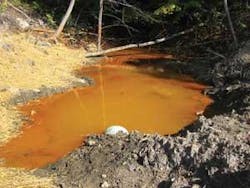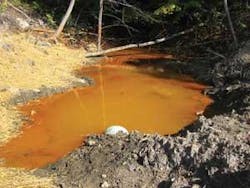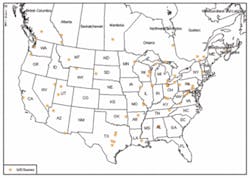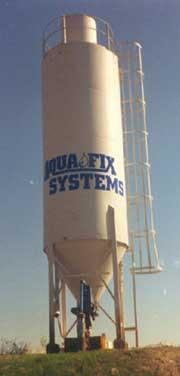Acid Mine Drainage Prevention Aided by LKD
by Terry Schmidt
Mining operations that encounter acidic materials must consider how these materials are handled and neutralized to ensure that Acid Rock Drainage (ARD) is prevented. In addition, many mining companies face challenges regarding ARD from prior mining activities. Lime Kiln Dust (LKD) is the material captured in air pollution control devices (e.g., baghouses) at lime plants. Skelly & Loy believes that LKD is underutilized as a source of alkalinity for prevention of ARD during mine reclamation activities and treatment of ARD during and following mining.
This dust typically consists of extremely fine particles less than 0.3 mm in size. LKD alkalinity is typically in the range of 90-110% CaCO3 equivalent. In other words, it has alkalinity equivalent to or better than high CaCO3 limestone. LKD is typically hauled to mining sites with on-road trucks and discharged pneumatically to a silo or directly spread on to a damp surface when used as a stabilizing agent. The primary alkaline component is CaO, which is quick acting and capable of raising the pH in water to a value higher than the level possible using limestone.
There are several methods where this dust has been used for mining remediation including: as an alkaline addition to acidic materials to prevent ARD formation; as a component of a mixture used to fill mine voids; as a component of a system to treat ARD; and as a direct application to acidic waters. Each potential application of LKD may have site specific advantages and disadvantages based on physical properties, chemical properties, and logistics.
LKD can be used as a stabilizing material for coal slurry and refuse, fly ash and dredge material. When mixed, the free lime in it activates the pozzolonic (cementitious) reaction with the silica and alumina in the fly ash. To take advantage of the stabilizing ability, the material must be kept in a dry condition prior to use. LKD is also beneficially used to increase coal slurry or ash pH and meet increasingly stringent regulatory limits related to potentially leached metals. It has been mixed with coal refuse at active coal processing facilities to increase pH and alkalinity, inhibit bacterial grown, and limit ARD formation. In this application, LKD has provided the added benefit of refuse bank structural stabilization.
Research has been conducted on filling underground and surface mine voids with mixtures containing LKD as a component of the fill for stabilization purposes. The Bark Camp Demonstration Project in Clearfield County in central Pennsylvania used a combination dredged material, fluidized bed coal combustion ash, and LKD as a stabilizing material to fill a large abandoned surface coal mining pit. The dust was utilized for its characteristics as a lime activator, providing strength to the fill mixture. The project's focus was filling a mine void while at the same time determining safe placement locations for a combination of river dredge material and fluidized bed coal combustion ash.
Significant quantities of acid-containing materials may be encountered that require neutralization at sites such as active and abandoned coal and hard rock mines, mineral processing operations, major road construction projects, or other major earth-moving projects. LKD is commonly used as a neutralization agent to mix with acidic material. One example is the use of it mixed with acid-forming materials at the PennDOT I-99 Construction Sections A-12 and C-12 located in Patton and Huston Townships, Centre County, PA. An engineered rock placement area was designed to contain nearly 700,000 cubic yards of acid-bearing waste rock. About 200,000 tons of the dust will be added during material placement through the end of 2008.
LKD has also been applied directly to acid impacted streams. The most common technique has been to store it in a silo and add the material to the stream using a water-wheel-driven or tipping bucket feed mechanism. The Maryland Bureau of Mines developed a network of doser systems within the Potomac River watershed which is severely impacted by abandoned coal mine drainage. Two of the six dosers were equipped to dispense LKD at the Kempton and McDonald Mine discharges. The Kempton Mine used an Aquafix water wheel doser while the McDonald Mine employed a water-powered EDI bucket doser. This technique using an Aquafix machine was also employed in the Monday Creek watershed in Ohio. LKD was also used in the Monday Creek watershed as an infiltration trench material. It was placed in areas along slopes designed to capture surface runoff (sometimes referred to as J-trenches). The trenches were designed to capture rainfall runoff and maximize contact with the dust to generate alkalinity. The highly charged alkaline water is then allowed to runoff over the surface or infiltrate into subsurface and neutralize the surrounding waters.
Surface mines that encounter acidic overburden may require the addition of alkaline material. This is a common requirement for coal mines operating in north-central Pennsylvania. The Moshannon District Mining Office regulates coal mining activities in Bradford, Cameron, Centre, Clearfield, Clinton, Lycoming, Potter, Snyder, Sullivan, Tioga and Union counties in north-central Pennsylvania. There are approximately 139 active coal mines inspected by the Moshannon office. On average, about two-thirds of these needed alkaline material added to ensure net alkaline conditions as a condition of their mining permits. Alkalinity application rates in the Moshannon district range from 100 tons per acre to 3,000 tons per acre with the typical average being in the range of 500-1,000 tons/acre. The typical surface mine is approximately 100 acres. Based on these typical factors, about 7 million tons of off-site alkaline material would be required over the life of these mines. Many coal mining companies within this region utilize LKD as an alkaline amendment to overburden material to meet regulatory requirements.
About the Author: Terry W. Schmidt is vice president of civil engineering and mine drainage services at Skelly & Loy Inc., a 180-person, Harrisburg, PA-based environmental engineering consulting firm in its 39th year. With five Mid-Atlantic offices, it's rated among the Top 200 Environmental Engineering Firms by Engineering News Record (ENR) magazine. Contact: 800-892-6532 or [email protected].


